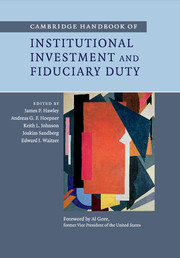Book contents
- Frontmatter
- Contents
- List of figures
- List of tables
- List of contributors
- Foreword
- 1 Introduction
- Part I Fiduciary duty: a global outlook
- Part II Fiduciary duty and the landscape of institutional investment
- Part III Challenging conventional wisdom on fiduciary duty
- 14 Is the search for excessive alpha a breach of fiduciary duty?
- 15 Fiduciary duty and sin stocks:is vice really nice?
- 16 Whose risk counts?
- 17 Sustainability, financial markets and systemic risk
- 18 Uncertain times, plural rationalities and the pension fiduciary
- 19 Emotional finance and the fiduciary responsibility of asset managers
- Part IV Towards a broader interpretation of fiduciary duty
- Part V Beneficiaries’ roles and viewpoints
- Part VI Fiduciary duty and governance
- Index
- References
14 - Is the search for excessive alpha a breach of fiduciary duty?
Published online by Cambridge University Press: 05 April 2014
- Frontmatter
- Contents
- List of figures
- List of tables
- List of contributors
- Foreword
- 1 Introduction
- Part I Fiduciary duty: a global outlook
- Part II Fiduciary duty and the landscape of institutional investment
- Part III Challenging conventional wisdom on fiduciary duty
- 14 Is the search for excessive alpha a breach of fiduciary duty?
- 15 Fiduciary duty and sin stocks:is vice really nice?
- 16 Whose risk counts?
- 17 Sustainability, financial markets and systemic risk
- 18 Uncertain times, plural rationalities and the pension fiduciary
- 19 Emotional finance and the fiduciary responsibility of asset managers
- Part IV Towards a broader interpretation of fiduciary duty
- Part V Beneficiaries’ roles and viewpoints
- Part VI Fiduciary duty and governance
- Index
- References
Summary
Introduction
Events of the past decade have challenged the efficient market hypothesis and the use of modern portfolio theory that is at its core as the basis for prudent investment and risk management practices. Accordingly, such questioning may – and we argue should – impact the legal framework governing pension fiduciaries. For example, it is now broadly accepted that most funds’ returns come from general exposure to the market (beta) rather than seeking market benchmark outperformance strategies (alpha) (Ibbotson 2010). This makes systemic market factors more critical to fiduciary responsibility. It also raises the question of whether large, highly diversified institutional “universal owners” should even attempt to employ alpha-seeking investment, or active management, as a major part of their portfolio (Hawley and Williams 2000). We argue that it is questionable at best and perhaps bad investment strategy at worst to devote significant resources to seeking above-market returns. Indeed, we suggest it raises questions about consistency with fiduciary obligations, since achieving alpha means besting the average return, which is a mathematical impossibility for the average investor. Additionally, alpha-seeking, if linked to leverage and/or use of derivatives, may contribute to systemic risk as well.
Our argument is as follows: alpha, or active management, has been, among both practitioners and academics, used in two quite different ways. In much but not all academic theory it is defined as above-market (risk-adjusted) returns (RAR) within an asset class (e.g., equity, real estate). This typically involves active trading (that is, stock picking/asset picking and cross asset investments of various types) rather than indexation. Yet it has also been widely used to mean seeking above-average return across asset classes. That is, typically using various alternative, sometimes leveraged investments (e.g., private equity, hedge funds, commodities) to increase portfolio-wide returns. Indeed, since the financial crisis this has been a pronounced trend for many defined benefit plans, as we discuss below.
- Type
- Chapter
- Information
- Publisher: Cambridge University PressPrint publication year: 2014
References
- 1
- Cited by



